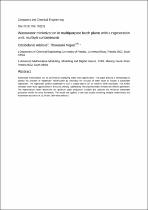 ResearchSpace
ResearchSpace
Wastewater minimization in multipurpose batch plants with a regeneration unit: multiple contaminants
JavaScript is disabled for your browser. Some features of this site may not work without it.
- ResearchSpace
- →
- Research Publications/Outputs
- →
- Journal Articles
- →
- View Item
| dc.contributor.author |
Adekola, O

|
|
| dc.contributor.author |
Majozi, T

|
|
| dc.date.accessioned | 2013-02-04T07:57:20Z | |
| dc.date.available | 2013-02-04T07:57:20Z | |
| dc.date.issued | 2011-12 | |
| dc.identifier.citation | Adekola, O and Majozi T. 2011. Wastewater minimization in multipurpose batch plants with a regeneration unit: multiple contaminants. Computers and Chemical Engineering, vol. 35(12), pp 2824-2836 | en_US |
| dc.identifier.issn | 0098-1354 | |
| dc.identifier.uri | http://journals2.scholarsportal.info/details.xqy?uri=/00981354/v35i0012/2824_wmimbpwarumc.xml | |
| dc.identifier.uri | http://hdl.handle.net/10204/6516 | |
| dc.description | Copyright: 2012 Elsevier. This is an ABSTRACT ONLY. The definitive version is published in Computers and Chemical Engineering, vol. 35(12), pp 2824-2836 | en_US |
| dc.description.abstract | Wastewater minimization can be achieved by employing water reuse opportunities. This paper presents a methodology to address the problem of wastewater minimization by extending the concept of water reuse to include a wastewater regenerator. The regenerator purifies wastewater to such a quality that it can be reused in other operations. This further increases water reuse opportunities in the plant, thereby significantly reducing freshwater demand and effluent generation. The mathematical model determines the optimum batch production schedule that achieves the minimum wastewater generation within the same framework. The model was applied to two case studies involving multiple contaminants and wastewater reductions of 19.2% and 26% were achieved. | en_US |
| dc.language.iso | en | en_US |
| dc.publisher | Elsevier | en_US |
| dc.relation.ispartofseries | Workflow;7716 | |
| dc.subject | Wastewater minimization | en_US |
| dc.subject | Regeneration | en_US |
| dc.subject | Multiple contaminants | en_US |
| dc.title | Wastewater minimization in multipurpose batch plants with a regeneration unit: multiple contaminants | en_US |
| dc.type | Article | en_US |
| dc.identifier.apacitation | Adekola, O., & Majozi, T. (2011). Wastewater minimization in multipurpose batch plants with a regeneration unit: multiple contaminants. http://hdl.handle.net/10204/6516 | en_ZA |
| dc.identifier.chicagocitation | Adekola, O, and T Majozi "Wastewater minimization in multipurpose batch plants with a regeneration unit: multiple contaminants." (2011) http://hdl.handle.net/10204/6516 | en_ZA |
| dc.identifier.vancouvercitation | Adekola O, Majozi T. Wastewater minimization in multipurpose batch plants with a regeneration unit: multiple contaminants. 2011; http://hdl.handle.net/10204/6516. | en_ZA |
| dc.identifier.ris | TY - Article AU - Adekola, O AU - Majozi, T AB - Wastewater minimization can be achieved by employing water reuse opportunities. This paper presents a methodology to address the problem of wastewater minimization by extending the concept of water reuse to include a wastewater regenerator. The regenerator purifies wastewater to such a quality that it can be reused in other operations. This further increases water reuse opportunities in the plant, thereby significantly reducing freshwater demand and effluent generation. The mathematical model determines the optimum batch production schedule that achieves the minimum wastewater generation within the same framework. The model was applied to two case studies involving multiple contaminants and wastewater reductions of 19.2% and 26% were achieved. DA - 2011-12 DB - ResearchSpace DP - CSIR KW - Wastewater minimization KW - Regeneration KW - Multiple contaminants LK - https://researchspace.csir.co.za PY - 2011 SM - 0098-1354 T1 - Wastewater minimization in multipurpose batch plants with a regeneration unit: multiple contaminants TI - Wastewater minimization in multipurpose batch plants with a regeneration unit: multiple contaminants UR - http://hdl.handle.net/10204/6516 ER - | en_ZA |





